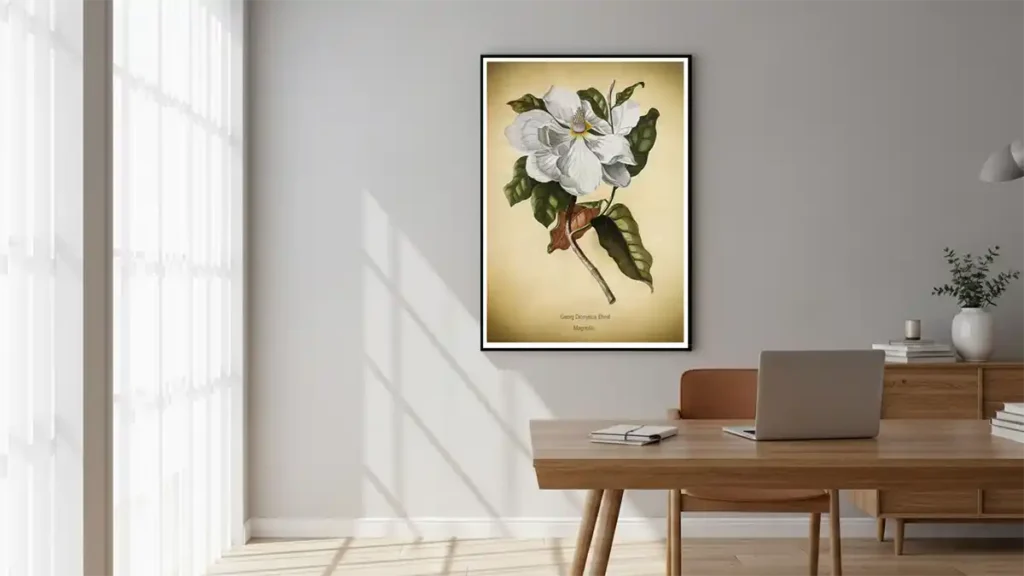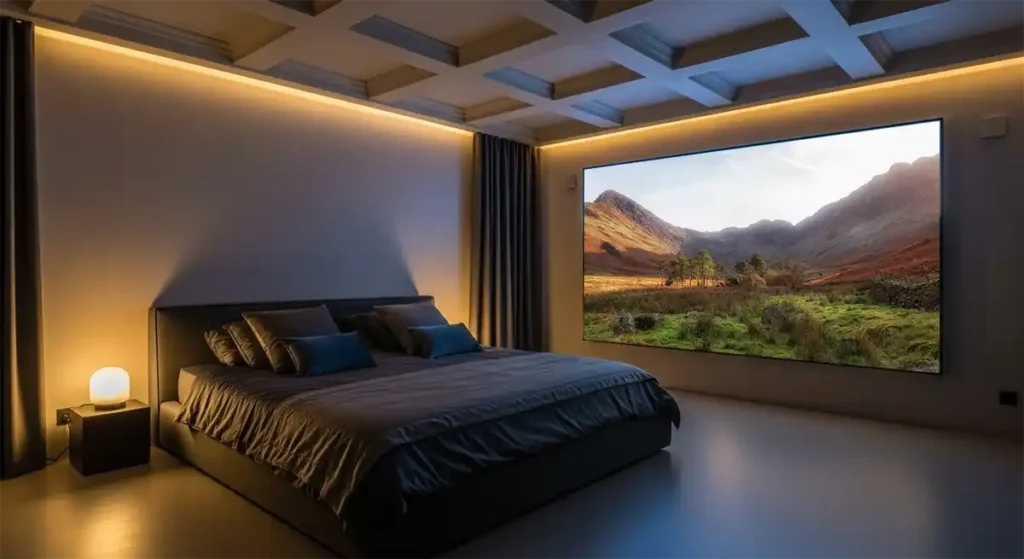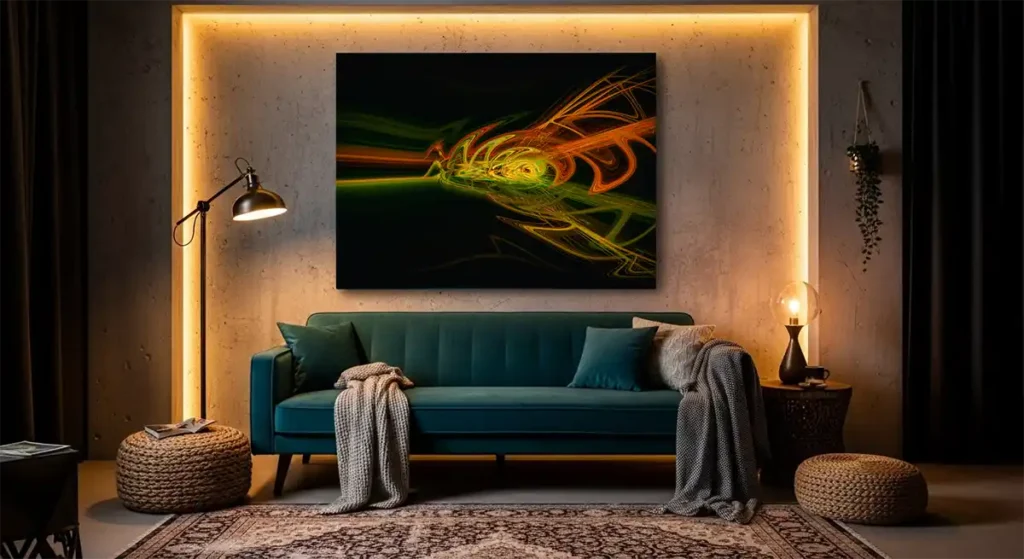Introduction: The Unseen Power of Your Walls
You know the basics of biophilic design: add plants, use natural materials, let in the light. These are the foundational pillars. But to create a space that doesn’t just look natural but truly feels restorative, you need to go deeper.
The most powerful, yet often overlooked, opportunities lie in the psychological principles within these pillars—the specific patterns and spatial relationships that our brains are hardwired to find calming and focusing.
This article explores three advanced principles that move beyond the obvious. We’ll show you how to leverage Complex Order, Prospect & Refuge, and Sensory Enticement through the most versatile tool in your design kit: your wall art.
Advanced Principle 1: Complex Order – The Architecture of Calm

The first pillar of biophilic design is “Nature in the Space.” The advanced principle within it is Complex Order.
Walk through a forest, and you’re surrounded by infinite complexity—but it’s not random. The branching of a tree, the spiral of a snail’s shell, the intricate veining of a leaf: these are all examples of nature’s “complex order.” Our brains are uniquely tuned to find these patterns subconsciously comforting. They provide stimulation without overwhelm, offering a visual rhythm that can calm the mind and aid concentration.
This is why a home office or study is the perfect place to leverage this principle. In a space dedicated to focus, visual chaos is the enemy. A blank wall is little better. But a wall adorned with the intricate, structured beauty of a botanical illustration provides the perfect balance.
Look at the image above. The Digitally Remastered Magnolia Art Print by Georg Dionysius Ehret isn’t just a beautiful picture of a flower. It is a map of natural order. Your eye doesn’t dart around anxiously; it follows the graceful curve of a petal, traces the delicate lines of the stamen, and gets lost in the harmonious whole. This is visual therapy for a distracted mind.
The application of this principle is simple:
- Where to Use It: Home offices, studies, libraries, and any space where mental clarity is the goal.
- How to Do It: Choose art that celebrates detail and structure. Vintage botanicals, scientific illustrations, and patterns inspired by natural forms are ideal. The key is intricacy with intention.
- The Effect: A reduction in mental fatigue and an environment that supports sustained focus by providing a gentle, structured visual anchor.
By choosing art that embodies complex order, you are not just decorating your wall—you are programming your environment for peace and productivity.
Advanced Principle 2: Prospect and Refuge – The Sanctuary and the Vista

The second pillar of biophilic design is “Nature of the Space.” It focuses on the spatial configurations that make us feel a certain way. The most powerful advanced principle within this pillar is Prospect and Refuge.
This concept is hardwired into our DNA. Our ancestors sought out environments that offered a “refuge”—a safe, enclosed, and protective space (like a cave or a dense thicket)—with a “prospect”—an open, unobstructed view to survey the landscape for resources and potential threats. This combination creates a profound sense of security and well-being.
In modern interiors, we can replicate this dynamic to create rooms that feel both incredibly cozy and expansively freeing. The bedroom is the ultimate refuge, a place for rest and recovery. But a low ceiling or a windowless wall can make it feel claustrophobic.
Look at the image above. The solution is not to tear down a wall, but to build a new vista. A massive, backlit print of Lake District Mountain Photography by Michael Paul Bennett does exactly that. The cozy, dimly lit bedroom provides the “refuge,” while the breathtaking, open landscape becomes the “prospect.” Your brain interprets this not as a picture on a wall, but as a safe haven with a commanding view. It’s the psychological equivalent of a mountain cabin.
The application of this principle is transformative:
- Where to Use It: Bedrooms, reading nooks, and any space where you want to feel secure, relaxed, and unhurried.
- How to Do It: Use large-scale, expansive landscape photography. The goal is to create a “window” to a distant, serene environment. Backlighting the art can enhance the effect dramatically, making the vista feel even more immersive.
- The Effect: It alleviates feelings of confinement and induces a state of calm alertness, reducing stress and promoting deeper rest.
By mastering Prospect and Refuge, you turn a simple bedroom into a restorative sanctuary, leveraging a deep-seated psychological need for safety and perspective.
Advanced Principle 3: Sensory Enticement – The Captivating Glow

The final pillar of biophilic design, “Natural Analogues,” uses forms and patterns that evoke nature. The advanced principle we derive from this is Sensory Enticement.
Throughout our evolution, we have been drawn to elements in nature that shimmer, glow, or possess a captivating depth—a sun-dappled forest floor, the reflective surface of a still pond at dusk, the mesmerizing dance of firelight. These phenomena promised resources, paths, or gathering places, holding our attention and sparking a sense of wonder and curiosity.
In interior design, you can harness this primal attraction to create a dynamic focal point that energizes a space and draws people in. This is not about creating literal representations, but about capturing that same quality of allure.
Look at the image above. The ‘Ripple in Time’ abstract from the Luminous Art Collection by Michael Paul Bennett is a masterclass in this principle. Its swirling vortex of greens, oranges, and yellows against a jet-black background doesn’t depict a specific natural scene. Instead, it behaves like one: it has the depth of a galaxy, the energy of a celestial event, and the allure of a glowing ember. It acts as a modern hearth—a captivating, almost magnetic presence in the living room that stimulates conversation and wonder.
The application of this principle is about creating energy:
- Where to Use It: Living rooms, entryways, and social spaces where you want to stimulate energy, conversation, and a sense of sophisticated drama.
- How to Do It: Choose art with luminosity, depth, and dynamic movement. Look for pieces that use light and color in a way that feels almost alive, creating a focal point you can’t look away from.
- The Effect: It transforms a static room into an engaging environment, sparking curiosity and providing a continuous source of visual and intellectual stimulation.
By employing Sensory Enticement, you move beyond passive decoration to active engagement. You install a piece that doesn’t just hang on the wall, but interacts with the space and the people in it, fulfilling a deep-seated human desire for wonder.
Conclusion: Your Blueprint for a Biophilic Sanctuary
We’ve moved beyond the simple advice of adding a plant. By understanding and applying these three advanced principles—Complex Order, Prospect and Refuge, and Sensory Enticement—you now have the blueprint to intentionally design a home that doesn’t just look good, but actively feels good.
Your environment is not a backdrop to your life; it is an active participant. The art you choose is the most powerful lever you can pull to influence it.
- In your office, use the intricate Complex Order of a vintage botanical to calm a distracted mind.
- In your bedroom, deploy the expansive Prospect and Refuge of a landscape to create a secure, restorative retreat.
- In your living room, harness the Sensory Enticement of luminous abstract art to spark energy and conversation.
This is the promise of Biophilic Design 2.0: a home that is not merely decorated, but deliberately crafted to support your well-being, focus, and joy. It’s a return to the environments we were built for, achieved through the art you love.
Ready to transform your space? Explore our printable art collections below to find the perfect piece to bring these principles to life.
- Shop Vintage Botanicals – For Complex Order
- Shop Landscape Photography – For Prospect and Refuge
- Shop Luminous Art – For Sensory Enticement
